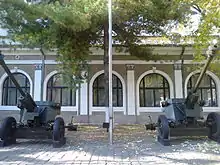Military Casino of Timișoara
The Military Casino, one of the oldest buildings of Timișoara, is situated on the west side of Liberty Square (Romanian: Piața Libertății), no. 7.[1] Its construction began in 1744 and was completed in 1775. The building eventually became a casino, although it did not start as one. At present it is ranked as a historical monument with the LMI Code TM-II –m-A-06143.[2]
| Military Casino of Timișoara | |
|---|---|
 | |
 Military Casino of Timișoara Location in Timișoara | |
| Location | Timișoara, Romania |
| Address | Liberty Square, no. 7[1] |
| Casino type | restaurant and ballroom |
| Owner | Ministry of National Defence |
| Coordinates | 45°45′20.9″N 21°13′35.2″E |
History

After the Austrians, led by Prince Eugene of Savoy, captured the Timișoara Fortress in 1716, the Turkish fortress was completely destroyed. Almost immediately the rebuilding of the fortress began according to Austrian standards. The surface to be surrounded by walls was enlarged, while the inner, ruined Turkish buildings were demolished. A plan of the fortress with perpendicular streets was drawn up. It had two squares that became Union Square and Liberty Square.[3]
Several buildings were built in Parade Square (called nowadays Liberty Square): the Town Hall (today known as "The Old Town Hall") and some buildings with military designation.[4]
In 1744 the construction of a house for military commander Count Soro was begun in the north-western corner.[5] In 1746–1747 the Mosque of the Silahdar was in the southern part of the house, on the site of the present façade of the casino. The Mosque was later pulled down.[1] In 1754 the house was expanded to the south on the surface of the former Mosque. Construction was finished in 1758. In 1775 the building was completed.[1][4][5] Initially the building had one floor. In 1910 others storeys were added. A hall with stained-glass windows and a terrace above were built to replace the summer terrace.[5]

In this building Otto Roth proclaimed the Banat Republic on 31 October 1918, but Aurel Cosma requested the Romanian officers to leave the casino. They went to the Kronprinz Hotel (in the present building of the Opera House[6]) where they established the National Romanian Military Council.[5]
In the period when the casino was administrated by Iuliu Illithy it was named "Grand Establisement Illithy". From 1921 it was named "The Military-Civil Casino 'Prince Carol'". After World War II it was known as "The Military Casino".[5] At present the building is known as the Military Club.[4]
In 2002 two 75 mm Reșița Model 1943 anti-tank cannons were placed in front of the terrace,[5] but they were removed after the square was redecorated in 2015.[7]
Architecture

The style of the building is Late Baroque. The double edged pilasters are in the Corinthian order with decorative elements on the façade. A Rococo element is the rounded corner in the northeast of the building.[1][5]
Since balls used to be an important part of the social life in towns at that time, the casino would house the officers’ balls in the Ball Room on the first floor.[4][5]
Footnotes
- (in Romanian) Cazinoul Militar, timisoara-info.ro, retrieved 2016-09-13
- (in Romanian) Lista Monumentelor Istorice 2015, Monitorul Oficial al României, partea I, nr. 113 bis, 15 februarie 2016, accesat 2020-06-13
- Valentin Capotescu. (2008) (in Romanian) Arhitectura militară bastionară în România, vol. I: Cetatea Timișoarei, Timișoara, Ed. Bastion, ISBN 978-973-88780-1-3, pp. 23–24
- Liana Păun. (in Romanian) Timișoara uitată: Piața Libertății sau cum s-a transformat Piața de Paradă în cartierul general al administrației civile și militare, pressalert.ro, 16 February 2014, retrieved 2016-09-13
- (in Romanian) Piata Libertății – Un centru militar pentru o cetate militară, timpolis.ro 6–9 October 2005, retrieved 2016-09-13
- Stefan Both. (in Romanian), Nostalgii timișorene. Amintiri despre orașul de altădată: Hoteluri și localuri de lux din secolele XVIII-XIX-lea, adevarul.ro, 7 April 2013, retrieved 2016-09-13
- Andreea Tobias, Liliana Iedu. (in Romanian) Reabilitarea centrului istoric al Timişoarei, finalizată după o investiţie de peste 65 milioane lei, zf.ro, 30 December 2015, retrieved 2016-09-13
| Wikimedia Commons has media related to Military Casino of Timișoara. |